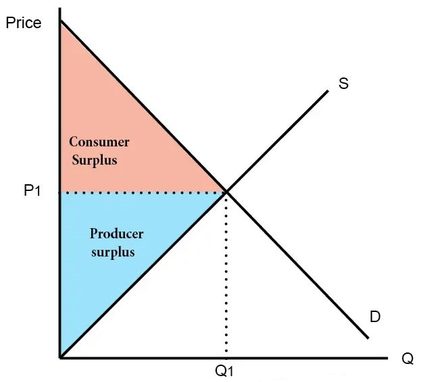Consumer Surplus Calculator
The consumer surplus calculator is a handy tool that helps you to compute the difference between what consumers are willing to pay for a good or service versus its market price. If you read on, you can learn what consumer surplus is, based on the consumer surplus definition. We will also show you how to find consumer surplus using the consumer surplus formula.
If you would like to learn some other microeconomics concepts, you may check our optimal price calculator or economic profit calculator.
As for now, however, let's focus on the definition and graph of the consumer surplus.
What is consumer surplus?
In economics, consumer surplus is defined as the difference between the price consumers actually pay and the maximum price they are willing to pay.
If you have ever attended an economics lecture, you have probably seen curves representing supply (S) and demand (D) as a function of price (P) versus quantity (Q).
If not, you can quickly grasp the concept in the consumer surplus graph below. The demand curve (D) is downward, as a lower price implies a higher demand for a given article. The supply curve (S), in contrast, is upward, since manufacturers produce more if they can sell their product at a higher price. The consumer surplus is the area between the equilibrium price (the level of price where the two curves cross each other) and the demand curve.

Now that you know what a consumer surplus is and how the consumer surplus graph looks like, let's find out how to calculate consumer surplus.
What is the the consumer surplus formula?
According to the consumer surplus definition, we need to determine the difference between how much the customer actually pays and the maximum price they are willing to pay. That is, the consumer surplus formula is the following:
consumer surplus = maximum price willing to pay - actual market price.
If you would like to estimate the consumer surplus for a whole economy, you need to use a slightly extended version of the formula, which you can reach in the related information of this consumer surplus calculator.
where:
- stand for Extended Consumer Surplus;
- is the quantity demanded at equilibrium, where demand and supply are equal;
- is the maximum price the buyer is willing to pay; and
- is the price at equilibrium, where demand and supply are equal.
How to find the consumer surplus? Example
Let's look at an example to make sure that you've understood the concept behind the consumer surplus.
You have decided to buy a football, and you are willing to pay $100 for it. You check on the Internet for their prices there, and you find a shop where you can buy it for $80.
This means that you can save $20 on the purchase compared to what you were willing to spend. The $20 is your consumer surplus, which you can now add to your savings, invest, or spend on other goods and services.
How to use the consumer surplus calculator?
You get the value of the consumer surplus immediately after setting the actual price and the maximum price that the buyer is willing to pay (willing price). Alternatively, you can set the consumer surplus and give one of the other two parameters to receive the missing one.
In related information, you can set the equilibrium price and the equilibrium quantity (the values where the supply and demand are equal), and you can read the value for the extended consumer surplus.
FAQs
How do I calculate the customer surplus?
In order to determine the customer surplus:
- Write down the actual price of an item.
- Write down how much the customers are willing to pay for this product.
- Compute the difference between the number from Step 1 and that from Step 2.
- The result is the customer surplus.
What is the customer surplus if the price is $20?
To know the customer surplus, you need to know how much people are willing to pay for this product. Assume it's $22. Then the customer surplus is $2 because we need to compute the difference between the actual price and what people are willing to pay: $22 - $20 = $2.